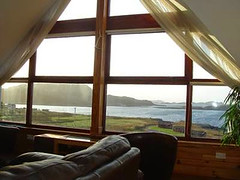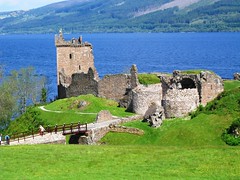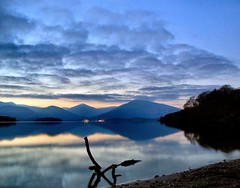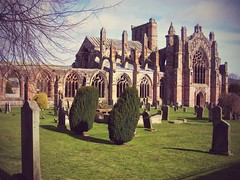Galloway Walking
AVOIDING THE MIDDLEGROUND OF MILD ENTHUSIASM
Galloway and its hills are a bit of an unknown quantity for most people but Dave Hewitt enthuses about the region and suggests more walkers should pay a visit.
To Galloway in late February, for Pete Drummond's final Donald. I used to go to Galloway often, particularly in the early and mid-1990s when I was living in Glasgow (handier than the current Stirling) and working through the Donalds myself.
Then there was a spell spent accompanying a Kilmarnock-based friend on the latter stages of his round, with the odd below-Donald-height trip thrown in as well. (Donalds are non-Highland Scottish hills over 610m/2000ft, basically.) Recent years have seen fewer visits however and I'd half forgotten, until rolling in along the A712 for Pete's do, how much I missed the place.
Galloway is an area like no other and I became - and remain - extremely fond of its strange combination of very easy walking - forest tracks everywhere - and the hardest, roughest, most tangled undergrowth to be found in Scotland. Forget Knoydart's Rough Bounds, Sutherland's hag-and-lochan moors or even the mid-height heathery bits of the Mounth or Kintyre: Galloway is in a class of its own, particularly in high summer when, to hijack a Michael Marra phrase, "the undergrowth is overgrown" and the air is stacked with wide-bodied insects circling as they lower their landing gear.
Just a few weeks before his completion jaunt, Pete Drummond had picked off the Galloway-heartland Donalds of Mullwharchar and Dungeon Hill, and he was wise to have done these in a frosty winter spell. In summer these are adventurous hills, requiring more effort and far more sweating and swearing, than a glance at the map or the altimeter might suggest.
For a good number of people reading this, there will be no need to explain the offbeat enjoyability of Galloway. The place has not just converts but also addicts, those for whom it is the best part of Scotland, the place to which they return more than anywhere else, just as some people are unable to stray from the Cairngorms, Skye or Assynt for very long.
But for others, Galloway will be a closed book, an area they have either never been to at all or where just one or two of the more landmarkish hills will have been picked off by uncharacteristically well-worn routes - Merrick, say, or Cairnsmore of Fleet from its southwestern side (the northern approaches are as rough as it gets - it's a very different hill via Craignelder), or maybe the eastern outlier of Criffel.
In a way, people's knowledge of Galloway tends to mimic the all-or-nothing mood of the place itself. There is easy walking and hard walking but next to nothing between. And there are those who go there often and those who never go at all but hardly anyone who occupies the middleground of mild enthusiasm. People tend to either love it or hate it, regard it as the finest of all acquired tastes or the worst of all possible dog's dinners.
Because of this and because of its geographical off-to-one-side nature (readily ignored by English types zooming up the M74 for their Munros and likewise snubbed by Scots heading south for a bit of fellbashing), Galloway is never going to be popular, even less trendy. It's massive, though - I once arranged to meet my sister in a cottage in Kirkcudbright and opted to cycle there from Dumfries. This took about twice as long as anticipated, despite good roads and a relatively quiet day on the headwind front. But even then I was only halfway across what could be termed Greater Galloway and the area stretches at least as far on the north-south axis as it does on the east-west.
It can also feel a long and tortuous way from anywhere by car. On the recent visit I had to head home that same evening and it felt like a major day once I'd driven 110 miles each way to and from the Murray's Monument car park west of Clatteringshaws. (For the record, the way I went - M74, then through the wonderful Dalveen Pass to Thornhill and the longer-than-it-looks Corriedoo road to New Galloway - was pretty much identical in time/distance to the return route through Dalmellington and the south side of Glasgow.)
Pete's chosen last in the list was Millfore, a sort of semi-outlier. Nothing like as cut off as traditional last Donalds such as Tinto, Cauldcleuch Head or the Cairnsmore of Fleet massif but still adrift enough from its Minnigaff neighbours Larg Hill, Lamachan Hill and Curleywee (great hill, great name - it's like a bigger version of Dumgoyne) for it to be most often tackled as a lone-hill outing. I'd been on it three times before - initially alone from Craigencallie to the northeast in April 1990, then as part of the full Minnigaff round from Auchinleck to the south in March 1991 and finally with my sister and her man - probably on that cycling holiday - again from Craigencallie. That had been in September 1993, so almost a decade had passed - scary.
This time we went from the monument, zigzagged around the Black Loch, then met the Craigencallie route at a sketchy path leading northwestward from the Poultrybuie Hill shoulder. It was a stroll in hazily benign conditions until meeting a strong and bitter east wind on the very highest slopes. Suddenly it was hard to stand up straight and we - there were five of us - were glad to tuck ourselves into the summit slope for lunch and completion cake.
(Anyone studying the 1997 edition of Munro's Tables, incidentally, risks being puzzled by Millfore's height. It's a Graham as well as a Donald, and the list of Grahams labels it a 657m hill whereas Percy Donald's list gives 656m. The grid ref is the same in each case but the Grahams figure is correct ' the 656m height is that of the trig point but there is a cairn around a metre higher just a few strides to the southwest.)
So Pete was complete, having started his Donalds with smooth Broad Law - almost the antithesis of Galloway - on 17 October 1964. A longer than average round - it's not uncommon to tick off the whole list of 140 summits (or a mere 118 if using Alan Dawson's New Donalds alternative) in half a dozen years. My erstwhile stand-in, Ronald Turnbull, holds the record for the fastest self-propelled round, and an extraordinary record at that - all 140 summits, plus ten "discards and extras", in nine days, 14 hours and 25 minutes. This was in May 1995, when he was young and keen and fit.
The oddest thing about Millfore is that for all its unsungness, it's now the joint fourth most common finishing Donald, having hosted three of the 93 known completions. For full details of who did what and when, have a look at the list here.
The day was young (and keen and fit), so there was support for my plan to head east for Craignell, a 477m Marilyn en route (ish) back to the road. This proved to be the best part of the day, conditions-wise, the skies retained their summer-like haze and the descent of the east side of Millfore was much rougher than the easy southern approach - typical Galloway, this. Nothing desperate but the small crags of Buckdas of Cairnbaber (where do they get these names?) needed picking through and there was some ice and a little residual snow. From below, in the haze, the summit we had left could easily have been taken for a Munro.
A high quality, semi-metalled forest road crosses the col before the intervening summit of Munwhul and half the party opted out here, preferring an amble back rather than the rough stuff beyond. We righteous ones continued, dipping again to power lines (where an unmapped track comes in from the north) and a steep-as-heather-comes haul up the ridge of Bennan, twig-clutching stuff but enjoyable in its way.
After regrouping and recovering on one of the summit slabs, all that remained was the treat of a traverse round to Craignell itself, not often climbed but a little hill with a disproportionate sense of space and remoteness. The descent southeast then south was trivial apart from a bit of Grade 1 tree scrabbling and soon we were back on track. The day's final pleasure was a rather eerie carved face on a stone in a gateway just before the final drop to the road. We hadn't noticed this on the way up as it had had its back - a plain uncarved stone - turned to us.
So a satisfying and very satisfactory day - more than six hours round, although we festered a fair bit up top. The views weren't great but the company was good and the landscape terrific. Needless to say, we didn't see or meet another soul. I could, I think, live in these parts and do the vast bulk of my walking on the Gallowegian hills. The megadamp climate would do my head in but better wet and hilly than dry and flat.
A couple of parish notices to end with. Ian Chalmers found an exposed film between Meall a'Bhuachaille and Creagan Gorm on Saturday 22 February - the same day that Pete Drummond was on Millfore, in fact. The film was lying near the top of the path leading down to Loch Morlich, at NH985116 on Landranger 36 and Ian reports that it appeared to have been dropped that day and was "not a bog standard Kodak but clearly used by someone keen on high-standard photography". If you think the film was yours, email Ian at This email address is being protected from spambots. You need JavaScript enabled to view it.
Short notice, I know, but Friday 21 March sees the annual Grampian Club lecture, to be given this year by the excellent and interesting Bob Aitken. He'll be speaking on "W H Murray - The Landscape Legacy", starting at 7.30pm in the Tower Extension lecture theatre at Dundee University. Tickets at the door - £4.
And that, I'm afraid to say, is the last of my Scotland On Line pieces. Chris Tyler (the cartoonist) and I would like to thank readers for their support, interest, thoughts and feedback over the two-and-a-half years that we've been doing this. Hopefully it's been informative, entertaining and stimulating, with not too much dull or mediocre stuff.
You'll still be able to find Chris and me in our other incarnation at The Angry Corrie - issue TAC57 goes to press this week and online versions of the previous 56 issues can be found here.
In respect of the Scotland On Line columns, thanks are due to Lorraine Wakefield and the late Alan Matheson for making the site such a lively and hillgoer-friendly place and also to everyone out there for being such an exceptionally good and friendly bunch of readers. It's been a pleasure.
Dave Hewitt 20/3/2003 from Scotland Online / Travel Scotland archives
More details about Walking In Scotland








